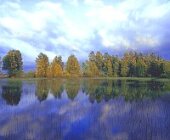  Water is a liquid. When you heat it, it moves around a lot faster. When the water reaches 100 degrees Celsius, it turns into a gas called water vapour. This gas is lighter* than the water around it, so it rises to the top. Then it escapes into the air. As more and more of the water turns into gas, more of it disappears into the air. After a while, every last drop of the water will be gone. Most of the bubbles start at the bottom, because that's where the heat is. The more heat you apply, the more bubbles you will get. The water is turning into a gas very quickly, and lots of bubbles form, and all try to rise to the surface at once. They push the water out of the way as they rise, and jump out of the surface. This is what we call 'boiling water'. The air we breathe always has water vapour in it. When you boil water, even more water vapour is in the air, and the air will feel damp when you breathe it. Water vapour is harmless. Eventually it will condense. This means it will turn back into water again. Did you know that water can turn into water vapour all by itself? If you leave a small glass of water on your kitchen counter for a week, eventually all the water will disappear! The heat in the room was enough to turn it into water vapour, which went into the air. Try it and see!  Here's a question for you. All of the water outside, like the water in this lake, gets heated by the sun, and turns into water vapour. This water vapour rises into the sky. Why don't all the lakes disappear? Where does the water vapour in the sky go to? What happens when the sky is really full of water vapour? Learn about the water cycle. |